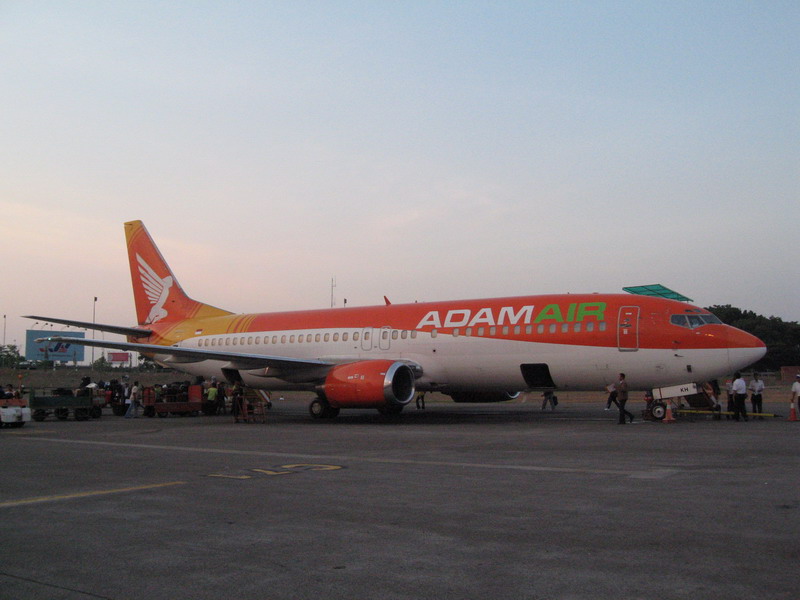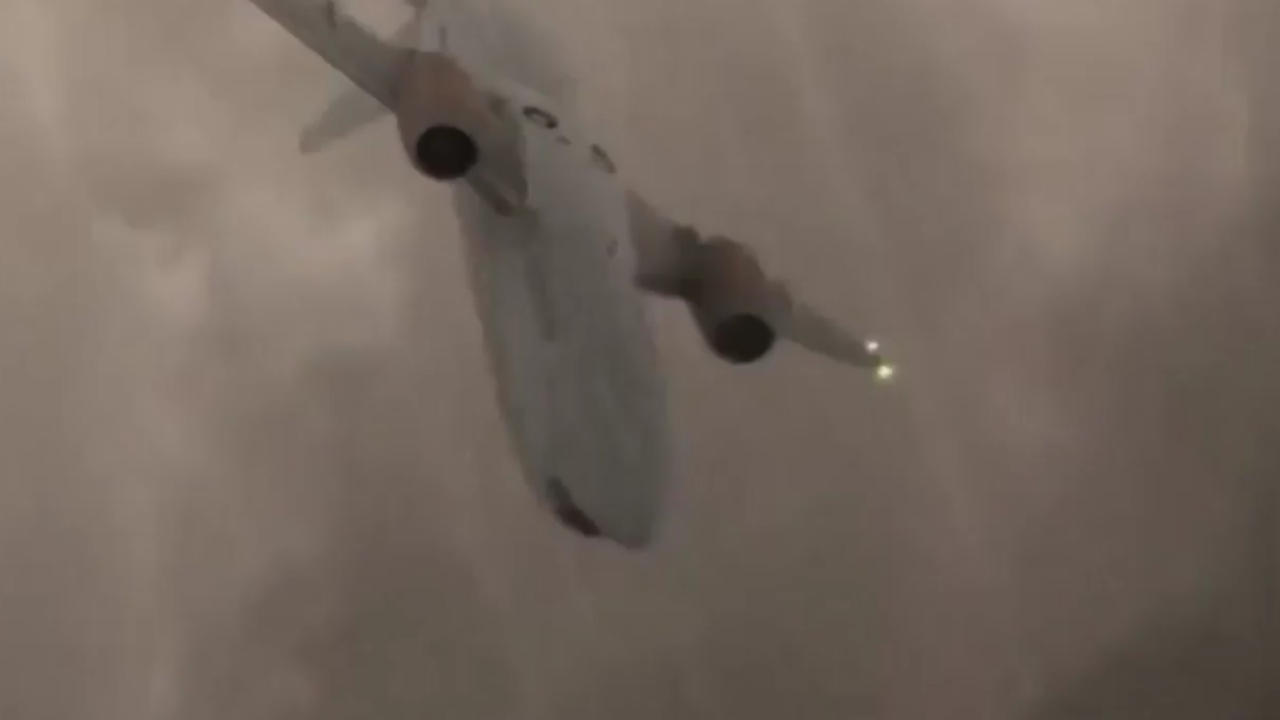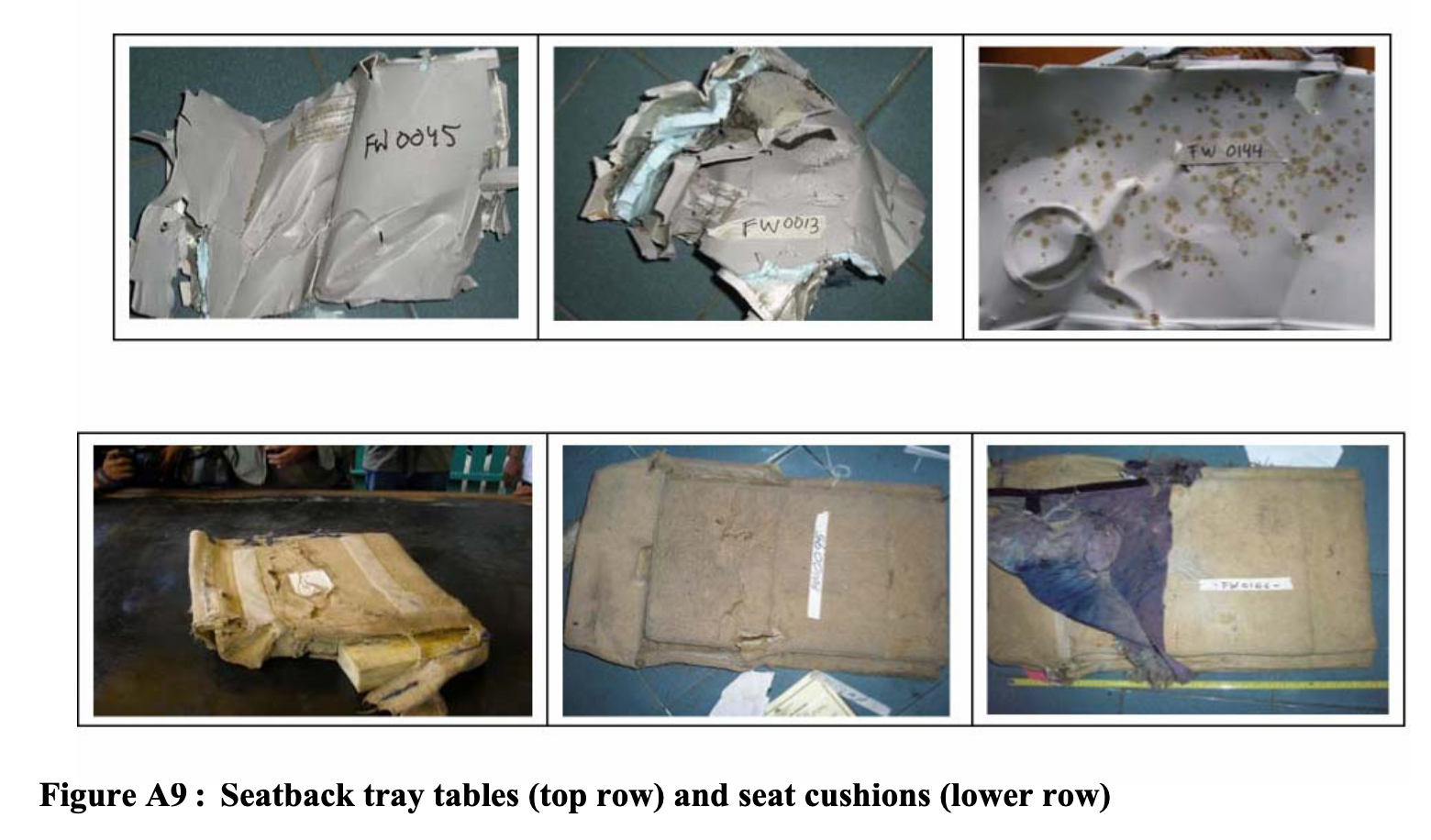01 January 2007 - AdamAir 574
On 1 January 2007, a Boeing Company 737-4Q8 aircraft, registered PK-KKW, operated by Adam SkyConnection Airlines (AdamAir) as flight number DHI 574, was on a scheduled passenger flight from Surabaya (SUB), East Java to Manado (MDC), Sulawesi, at FL 350 (35,000 feet) when it disappeared from radar. The aircraft departed from Djuanda Airport, Surabaya at 05:59 Coordinated Universal Time (UTC) under the instrument flight rules (IFR), with an estimated time of arrival (ETA) at Sam Ratulangi Airport, Manado of 08:14. The pilot in command (PIC) was the pilot flying for the sector to Manado and the copilot was the monitoring/support pilot. There were 102 people on board; two pilots, 4 cabin crew, and 96 passengers comprised of 85 adults, 7 children and 4 infants. The Indonesian Navy, Army, Air Force, Police, and Search and Rescue organization, a Singaporean Air Force Fokker 50 aircraft, the USNS Mary Sears, National Transportation Safety Committee of Indonesia, Air Accident Investigation Bureau of Singapore, Singapore Navy Divers, and other resources searched for the wreckage of PK-KKW in the Makassar Strait, in the vicinity of the last radar return. Nine days after the aircraft disappeared, wreckage was found in the water and on the shore along the coast near Pare-Pare, Sulawesi. Locator beacon signals from the flight recorders were heard on 21 January 2007 and their positions logged. The attempt to recover the recorders was suspended when it was determined that the wreckage was located in the ocean at a depth of about 2,000 meters, requiring specialized recovery equipment not available in the Region.

The salvage operation to recover the flight recorders commenced on 24 August 2007 and the DFDR and CVR were recovered on 27 and 28 August 2007 respectively. The CVR revealed that both pilots were concerned about navigation problems and subsequently became engrossed with trouble shooting Inertial Reference System (IRS) anomalies for at least the last 13 minutes of the flight, with minimal regard to other flight requirements. This included identification and attempts at corrective actions. The DFDR analysis showed that the aircraft was in cruise at FL 350 with the autopilot engaged. The autopilot was holding 5 degrees left aileron wheel in order to maintain wings level. Following the crew’s selection of the number-2 (right) IRS Mode Selector Unit to ATT (Attitude) mode, the autopilot disengaged. The control wheel (aileron) then centered and the aircraft began a slow roll to the right. The aural alert, BANK ANGLE, sounded as the aircraft passed 35 degrees right bank. The DFDR data showed that roll rate was momentarily arrested several times, but there was only one significant attempt to arrest the roll. Positive and sustained roll attitude recovery was not achieved. Even after the aircraft had reached a bank angle of 100 degrees, with the pitch attitude approaching 60 degrees aircraft nose down, the pilot did not roll the aircraft’s
wings level before attempting pitch recovery in accordance with standard operating procedures. The aircraft reached 3.5g, as the speed reached Mach 0.926 during sustained nose-up elevator control input while still in a right bank. The recorded airspeed exceeded Vdive (400 kcas), and reached a maximum of approximately 490 kcas just prior to the end of recording.
A thump, thump sound was evident on the CVR about 20 seconds from the end of the recorded data. Flight recorder data indicated that a significant structural failure occurred when the aircraft was at a speed of Mach 0.926 and the flight load suddenly and rapidly reversed from 3.5g to negative 2.8 g. This g force and airspeed are beyond the design limitations of the aircraft. At the time of the thump, thump sound, the aircraft was in a critically uncontrollable state. The PIC did not manage task sharing and crew resource management practices were not followed. There was no evidence that the pilots were appropriately controlling the aircraft, even after the BANK ANGLE alert sounded as the aircraft’s roll exceeded 35 degrees right bank.
This accident resulted from a combination of factors, including the failure of the pilots to adequately monitor the flight instruments, particularly during the final 2 minutes of the flight. Preoccupation with a malfunction of the Inertial Reference System (IRS) diverted both pilots’ attention from the flight instruments and allowed the increasing descent and bank angle to go unnoticed. The pilots did not detect and appropriately arrest the descent soon enough to prevent loss of control.
At the time of the accident, AdamAir did not provide their pilots with IRS malfunction corrective action training in the simulator, nor did they provide aircraft upset recovery training in accordance with the Airplane Upset Recovery Training Aid developed by Boeing and Airbus.
In accordance with Civil Aviation Safety Regulations, Indonesian operators are required to provide training in emergency or abnormal situations or procedures. However, at the time of the accident, the Indonesian regulations did not specifically require upset recovery to be included in their flight operations training. Technical log (pilot reports) and maintenance records showed that between October and December 2006, there were 154 recurring defects, directly and indirectly related to the aircraft’s Inertial Reference System (IRS), mostly the left (number-1) system. There was no evidence that the airline’s management was aware of the seriousness of the unresolved and recurring defects. There was no evidence that AdamAir included component reliability in their Reliability Control Program (RCP) to ensure the effectiveness of the airworthiness of the aircraft components for the fleet at the time of the accident. There was no evidence, that prior to December 2006, DGCA was actively ensuring that AdamAir was rectifying the numerous IRS defects on aircraft in the AdamAir Boeing 737 fleet, despite the IRS malfunction serious incident months earlier. The DGCA was also unaware that the AdamAir component reliability RCP did not assure the effectiveness of the airworthiness of the aircraft components for the AdamAir fleet.
The investigation found that the IRS defects in the AdamAir fleet had not been resolved by December 2007. There were 82 IRS/IRU (Inertial Reference Unit) defects logged in the Boeing 737 fleet during the September, October, November 2007 period.
During the investigation, the NTSC issued a number of recommendations to the Directorate
General Civil Aviation (DGCA) and Adam SkyConnection Airline (AdamAir) relating to IRS maintenance and training of flight crews in IRS and aircraft upset recovery.

AdamAir advised the NTSC and DGCA that it has taken safety action to address the IRS defect troubleshooting procedures and maintenance oversight supervision. It issued Engineering Orders with instructions and procedures for the evaluation and rectification of repetitive IRS problems, and from November 2007, has had extensive liaison with the IRU manufacturer.
The safety action taken to date by AdamAir includes ground school and aircraft simulator training for pilots to ensure proficiency in upset recovery from 14 January 2008.
The DGCA advised the NTSC that on 23 November 2007 it issued a Safety Circular, to all
operators, requiring specific action to address deficiencies noted by the NTSC, in particular the IRS maintenance and pilot training deficiencies. The DGCA requires operators to conduct continuing analysis and surveillance of repetitive defects and ensure immediate follow up corrective action. The DGCA has informed operators that it is actively monitoring aircraft defects, in particular repetitive defects, and when the on-condition basis of maintenance is deemed to be insufficient to eliminate repetitive defects, DGCA will require component replacement on a hard-time basis.
On 10 March 2008, the DGCA informed the NTSC that in addition to requiring upset recovery training from 8 January 2008, the DGCA requires operators to include spatial disorientation and its effects in their syllabus of initial and recurrency training. The DGCA plans to ensure, through routine flying operations inspections, that operators and flying schools are complying with this requirement.
The DFDR showed that the aircraft was in cruise at Flight Level (FL) 350 (35,000 ft), at a speed of Mach 0.75, with autopilot ‘A’ engaged. Autopilot modes selected by the crew were Heading SEL and VNAV. At 06:56:35, autopilot A was changed from VNAV mode to Altitude Hold mode.
The number-1 (left) IRS, number-1 (left) Electronic Attitude Display indicator (EADI), and the Standby Attitude Direction Indicator (ADI) were available.
The following is from the CVR transcript:
06:56:55.2 PIC put the IRS in attitude
[mode on the IRS Mode Selector Unit].
06:56:57.9 Copilot will do sir
06:57:14.0 PIC enter into
06:57:15.9 PIC still fail
06:57:17.6 Copilot fail
06:57:18.2 PIC yes there’s a fault. Select Attitude
06:57:26.1 Copilot IRS mode selector
06:57:28.3 PIC attitude left
06:57:29.3 Copilot left one
06:57:34.0 PIC after this, heading set, enter ya
(setelah ini heading set ya, masukin ya).
06:57:36.0 Sound of autopilot disengage lasting approximately 4 seconds.
When ATT (Attitude) was selected in the IRS Mode Selector Unit, it resulted in the autopilot disengaging. The effect on the copilot’s EADI of switching from NAV to ATT was that the following displays were lost:
· Roll indication
· Horizon scale
· Pitch scale
· Sky/ground shading.
Flight path angle, Acceleration, Pitch Limit display and Traffic Alert and Collision Avoidance System (TCAS), Resolution Advisory (RA) commands are also removed when ATT is selected.
Based on information from the DFDR, attitude data from at least one IRU was valid and contained expected pitch and roll data throughout the incident flight. The continuity of the recorded parameters also indicates that the IRU source of this data was not switched during the flight.
The Ground Proximity Warning System (GPWS) provides bank angle alert11.
The GPWS receives IRU attitude data from only the Left IRU. During the flight, the Cockpit Voice Recorder (CVR) recorded bank angle alerts when the aircraft attitude was about 35 degrees right wing down. This is an indication that left IRU was operational and providing attitude data to the GPWS at this time.
Throughout most of the flight, the autopilot had been holding some left wheel (aileron) to hold wings level. Just prior to the autopilot disengaging, the autopilot was holding approximately 5 degrees of left wheel. At 06:57:36, the autopilot disengaged, and the wheel returned to center. This resulted in a slow right roll of approximately 1 degree per second. The roll rate was arrested with the wheel (aileron) at 06:57:45, and again at 06:58:00, but the wheel inputs were momentary, and the aircraft continued to roll to the right. The aural alert BANK ANGLE, BANK ANGLE, BANK ANGLE, BANK ANGLE occurred at 06:58:10.6 when the aircraft reached 35 degrees of bank angle.
Again the bank angle was briefly arrested, but was followed momentarily by a right wing down wheel input.
At 06:58:23, sufficient wheel (approx 15 deg) was used to reverse the roll rate, but again was followed by right wheel input, continuing the right wing down roll rate.
Subsequently the pilot began to pull on the control column (elevator), modestly at first, commanding approximately 1.1g12. As the aircraft rolled right through 60 degrees of bank angle, the pilot began to steadily increase control column pull (elevator), while continuing to roll right. The pitch attitude at 06:58:23 was approximately 5 degrees aircraft nose down. Shortly after, the aircraft’s pitch rate increased to 2.3 deg/sec aircraft nose down. The pitch attitude reached negative 60 degrees (nose down) at 06:58:50. The pitch rate subsequently became positive, reducing the nose-down attitude.
The CVR revealed that both pilots became engrossed with trouble shooting Inertial Reference System (IRS) anomalies for at least the last 13 minutes of the flight, with minimal regard to other flight requirements. For about 46 seconds after the autopilot disengaged, the pilots were completely occupied with trouble shooting. This included attempts to identify the IRS problems, and some attempts at corrective actions of the IRS and the navigation instruments.
Even after the first BANK ANGLE, BANK ANGLE, BANK ANGLE, BANK ANGLE alert sounded at 06:58:10.6, the crew did not make timely and appropriate flight control inputs to recover control of the aircraft. There was no evidence that either of the pilots appropriately referenced the flight instruments.
The aircraft reached a maximum right bank angle of 100 degrees at 06:58:38. At that time, approximately 2g was being commanded by crew action, while the roll rate was being reversed, using an oscillatory wheel input of between 10-20 degrees. Subsequent action was taken to roll the aircraft towards wings level using a bank angle of less than 20 degrees (aileron), with the aircraft rolling left at a rate of approximately 4 degrees per second, towards wings level. During this roll, nose-up elevator in excess of 2gs of force was commanded. Nose-up elevator input continued, resulting in 3g force at 06:58:58 with 42 degrees of bank, then 3.5g by 06:59:04 with 32 degrees of bank. During that time period, airspeed had accelerated past Mmo (0.82) and was approaching Mdive (0.89).
The Boeing Quick Reference Handbook, Maneuvers, Non-Normal Maneuvers, page MAN.1.7, Nose Low Recovery, requires the pilot flying to: *Roll in the shortest direction to wings level (unload and roll if bank angle is more than 90 degrees).
The instruction has a warning note: Warning: *Excessive use of pitch trim or rudder may aggravate an upset situation or may result in loss of control and/or high structural loads.
The Boeing upset recovery procedure requires roll to wings level before applying nose-up elevator. The DFDR showed that this procedure was not followed by the crew.
The maximum recorded Mach number reached was 0.926, at 06:58:51. Airspeed exceeded Vdive (400 kcas), and reached a maximum of approximately 490 kcas just prior to the end of recorded data. The descent between recorded data altitudes of 35,008 feet and 9,920 feet took 75 seconds, giving an average vertical speed (rate of sink) of 20,070 feet per minute. The maximum recorded rate of descent was 53,760 feet per minute at 06:58:48. Between 06:58:42 and 06:58:57, the average rate of descent was 46,88 feet per minute, and between 06:59:01 and 06:59:12 was 24,576 feet per minute. (See Figure 7.)
The g forces eventually reached about 3.5gs as the Mach number reached a maximum of 0.926. The 3.5 g force and Mach 0.926 airspeed are beyond the designed limitations of the aircraft. Federal Aviation Regulation (FAR) 25.333 covers maneuver envelopes for structure design. FAR 25.333 shows the v-vs-n maneuvering envelope. At dive speeds, structures are required to maintain integrity 0-2.5g's.
At 06:59:06, the normal load factor reversed from a positive 3 to 3.5g to a negative 2.8g, and the pitch rate reversed from a positive 4 deg/sec to a negative 6 deg/sec.
Flight recorder data indicated that a significant aerodynamic structural failure occurred when the aircraft was at a speed of Mach 0.926 and the flight load suddenly and rapidly reversed from 3.5g to negative 2.8 g. A thump, thump sound, which coincided with the time of the sudden flight load reversal, was evident on the CVR about 20 seconds from the end of the recorded data. At the time of the thump, thump sound, the aircraft was already in a critically uncontrollable state.
The last recorded valid pressure altitude data point was at 9,920 feet. The DFDR continued to record other valid parameters until it stopped completely at about 9,000 feet.
Download the full NTSB report


